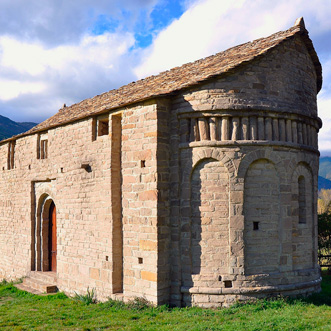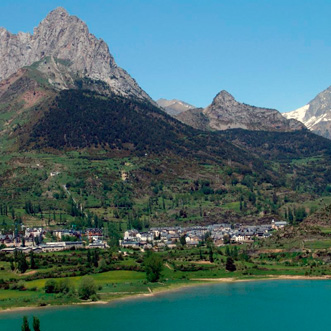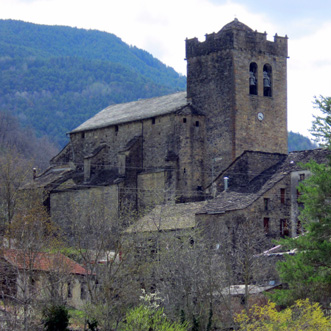
TENA VALLEY’s VILLAGES
The Tena Valley and the towns and villages it beholds have a long and rich history. This history can be seen reflected in its stone walls, its coats of arms carved in wood and stone, Gothic churches, its Romanesque arches which shape the streets and chapels with history and legends, such as Santa Elena’s. These are just some of the many historic treasures that you can discover in its towns and villages.
Sallent de Gállego
Sallent de Gállego is the heart of the Tena Valley. Located at the beggining of Lanuza reservoir and under the lookout of the peak Peña Foratata, it proudly conserves a 15th century Gothic-style church with an impressive Plateresque altarpiece. History of the periods that the village has lived through can also be seen in a Roman bridge that rests on top of the Gallego River next to a kids’ park and a triple Romanesque arch in the main square. Together with its wide services’ offer, Sallent de Gállego is a wonderful place to spend your holidays all year round.
Panticosa
One of the favourite destinations in the Tena Valley is the beautiful Panticosa. Just like the other towns and villages, it’s built in the popular architectural style in the area, with stone and slate. Many of its houses date back to the 19th century; this can be seen in its semi-circular and linteled porticos and also in the coats of arms that the nobility carved in its walls and doors.
Strolling around Panticosa, you mustn’t miss the most impressive of its buildings: the 16th century church ‘La Asunción’ with its powerful altarpiece on the main altar.
Lanuza
This charming, and tiny, village was relocated and reconstructed by its inhabitants after the creation of the reservoir that bears its name. Walk around its streets and admire the linteled porticoes bearing coats of arms that were carved over two centuries ago. Don’t miss the chance to eat a meal in ‘El Frondón’, a restaurant that offers some delicious traditional dishes.
Sandiniés
Sandiniés is a small village in which the calmed feeling of the Tena Valley conveys. The village, located at 1.294 metres ASL, has a strong essence and it conserves the traditional features, common to the valleys, in its streets, buildings, doorways and heraldic coats of arms. One of the prettiest places to visit is the Eras viewpoint; it has an excellent view over the valley.
Tramacastilla
In the nearby of Sandiniés and also in the heights, at 1.224 metres ASL, this beautiful village lies on a sunny slope at the bottom part of the valley. The village is masked amongst pines, oak groves and meadows. The landscape that can be seen from the ‘cabezo de Santa Marina’ hilltop is breath taking. And of course, don’t forget to try the ‘Migas al pastor’, a traditional shepherd’s dish, which you will find in almost every restaurant in town.
Hoz de Jaca
Its location makes it a natural viewpoint. The village hangs on top of a cliff with a direct view to Bubal Reservoir, a balcony to its waters. It is a magnificent starting point to go hiking on to beautiful routes to different peaks that vary on difficulty. We recommend: a chilled climb from Hoz de Jaca to Panticosa via Fratacoz; a hike from Hoz de Jaca to El Pueyo via La Aliana and as third option, the ascent to the Sabocos glacial lakes. Moreover, in Hoz de Jaca you will find Europe’s longest zip line with a trail that goes over the reservoirs waters and forests of the nearby. The village can be reached via El Pueyo de Jaca or the Bubal reservoir.
El Pueyo de Jaca
On the banks of Búbal reservoir lays this charming village, at the confluence of the rivers Gállego and Caldarés and located at 1.091 metres ASL. One of the most relevant sightseeing points of the village is the striking parish church of San Miguel. It was built in the 16th century and later incorporated into the 18th century structure. The church has a single nave with side chapels and above the doorway, facing the sacristy, is a figure that dates back to 1580.



